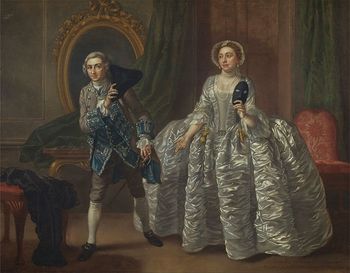Annotation:Harlyquin Ranger: Difference between revisions
No edit summary |
m Text replacement - "garamond, serif" to "sans-serif" |
||
| Line 1: | Line 1: | ||
=='''Back to [[{{BASEPAGENAME}}]]'''== | =='''Back to [[{{BASEPAGENAME}}]]'''== | ||
---- | ---- | ||
<p><font face=" | <p><font face="sans-serif" size="4"> | ||
'''HARLYQUIN RANGER'''. AKA - "[[Harlequin Ranger]]." English, Jig. B Flat Major. Standard tuning (fiddle). AABB. '''Harlequin Ranger''' was a pantomime produced by David Garrick in London in 1751, a burlesque of Rich's Covent Garden pantomimes which mocked the entertainment of wire dancing and the antics of strange animal's in Rich's theatre. When Rich's friends attended Garrick's play, they attempted to disrupt the performance by throwing an apple at the comic actor Henry Woodward, who retorted with a sarcastic comment from the stage. A lawsuit ensued. The melody first appears in John Hinton's '''Universal Magazine of Knowledge and Pleasure''' (London, 1754). Subsequently it was published in John Johnson's '''200 Favourite Country Dances, vol. 7''' (London, 1756), and Charles and Samuel Thompson's 1757 country dance volume. In America, the tune was included in the 1788 music manuscript copybook of John and William Pitt Turner, fiddlers from Norwich, Conn. [[File:garrickranger.jpg|350px|thumb|right|David Garrick as Ranger in Hoadly's comedy "The Suspicious Husband" (1747). By Francis Hayman. Ranger was a stock character of the mid-18th century London stage.]] | '''HARLYQUIN RANGER'''. AKA - "[[Harlequin Ranger]]." English, Jig. B Flat Major. Standard tuning (fiddle). AABB. '''Harlequin Ranger''' was a pantomime produced by David Garrick in London in 1751, a burlesque of Rich's Covent Garden pantomimes which mocked the entertainment of wire dancing and the antics of strange animal's in Rich's theatre. When Rich's friends attended Garrick's play, they attempted to disrupt the performance by throwing an apple at the comic actor Henry Woodward, who retorted with a sarcastic comment from the stage. A lawsuit ensued. The melody first appears in John Hinton's '''Universal Magazine of Knowledge and Pleasure''' (London, 1754). Subsequently it was published in John Johnson's '''200 Favourite Country Dances, vol. 7''' (London, 1756), and Charles and Samuel Thompson's 1757 country dance volume. In America, the tune was included in the 1788 music manuscript copybook of John and William Pitt Turner, fiddlers from Norwich, Conn. [[File:garrickranger.jpg|350px|thumb|right|David Garrick as Ranger in Hoadly's comedy "The Suspicious Husband" (1747). By Francis Hayman. Ranger was a stock character of the mid-18th century London stage.]] | ||
<br> | <br> | ||
<br> | <br> | ||
</font></p> | </font></p> | ||
<p><font face=" | <p><font face="sans-serif" size="4"> | ||
''Source for notated version'': | ''Source for notated version'': | ||
<br> | <br> | ||
<br> | <br> | ||
</font></p> | </font></p> | ||
<p><font face=" | <p><font face="sans-serif" size="4"> | ||
''Printed sources'': Thompson ('''Compleat Collection of 200 Favourite Country Dances, vol. 1'''), 1757; No. 77. | ''Printed sources'': Thompson ('''Compleat Collection of 200 Favourite Country Dances, vol. 1'''), 1757; No. 77. | ||
<br> | <br> | ||
<br> | <br> | ||
</font></p> | </font></p> | ||
<p><font face=" | <p><font face="sans-serif" size="4"> | ||
''Recorded sources'': <font color=teal></font> | ''Recorded sources'': <font color=teal></font> | ||
</font></p> | </font></p> | ||
Revision as of 13:22, 6 May 2019
Back to Harlyquin Ranger
HARLYQUIN RANGER. AKA - "Harlequin Ranger." English, Jig. B Flat Major. Standard tuning (fiddle). AABB. Harlequin Ranger was a pantomime produced by David Garrick in London in 1751, a burlesque of Rich's Covent Garden pantomimes which mocked the entertainment of wire dancing and the antics of strange animal's in Rich's theatre. When Rich's friends attended Garrick's play, they attempted to disrupt the performance by throwing an apple at the comic actor Henry Woodward, who retorted with a sarcastic comment from the stage. A lawsuit ensued. The melody first appears in John Hinton's Universal Magazine of Knowledge and Pleasure (London, 1754). Subsequently it was published in John Johnson's 200 Favourite Country Dances, vol. 7 (London, 1756), and Charles and Samuel Thompson's 1757 country dance volume. In America, the tune was included in the 1788 music manuscript copybook of John and William Pitt Turner, fiddlers from Norwich, Conn.

Source for notated version:
Printed sources: Thompson (Compleat Collection of 200 Favourite Country Dances, vol. 1), 1757; No. 77.
Recorded sources:
